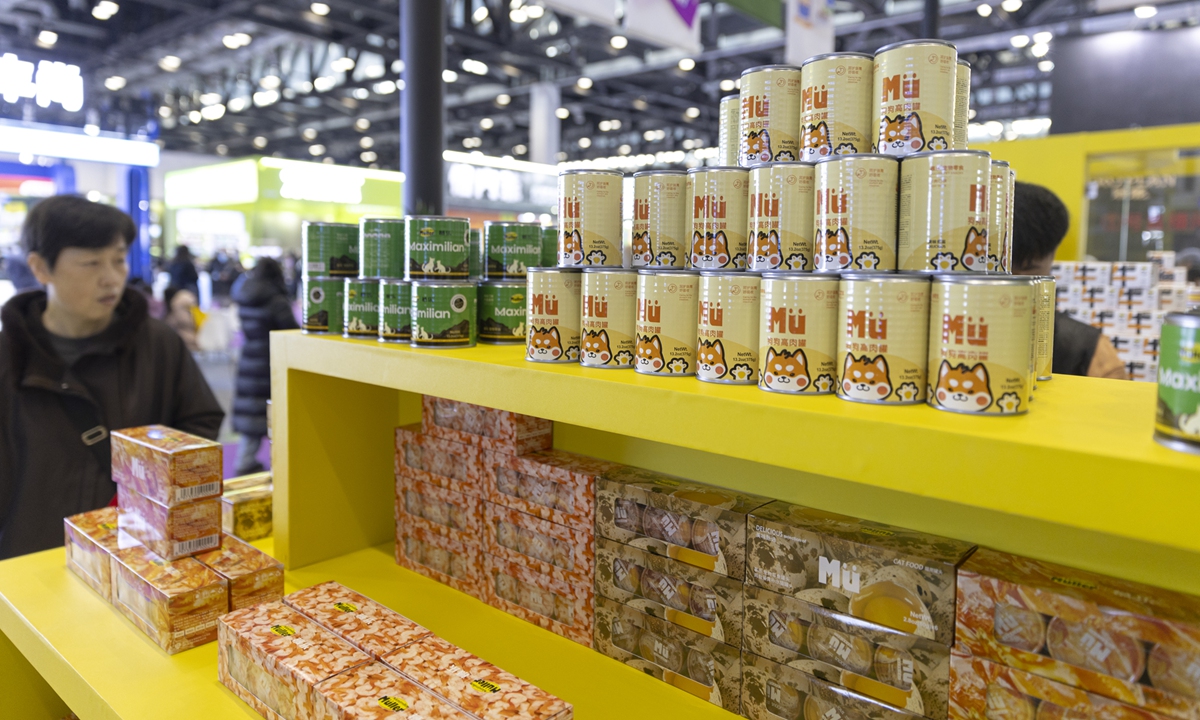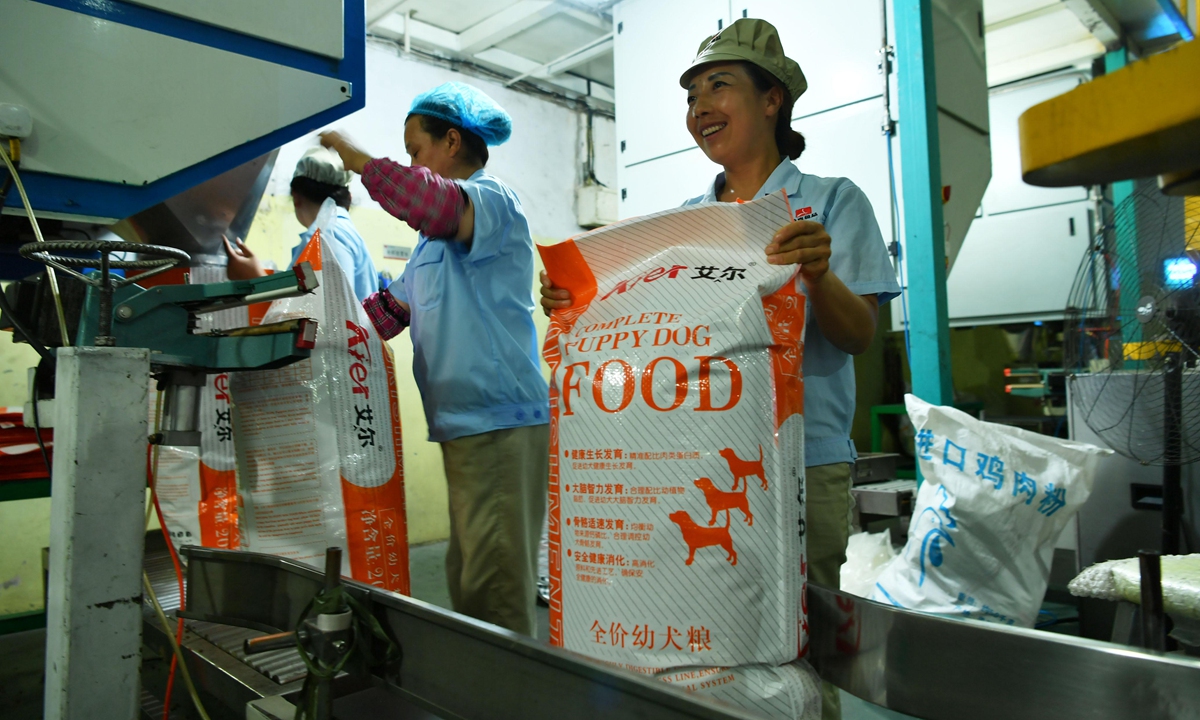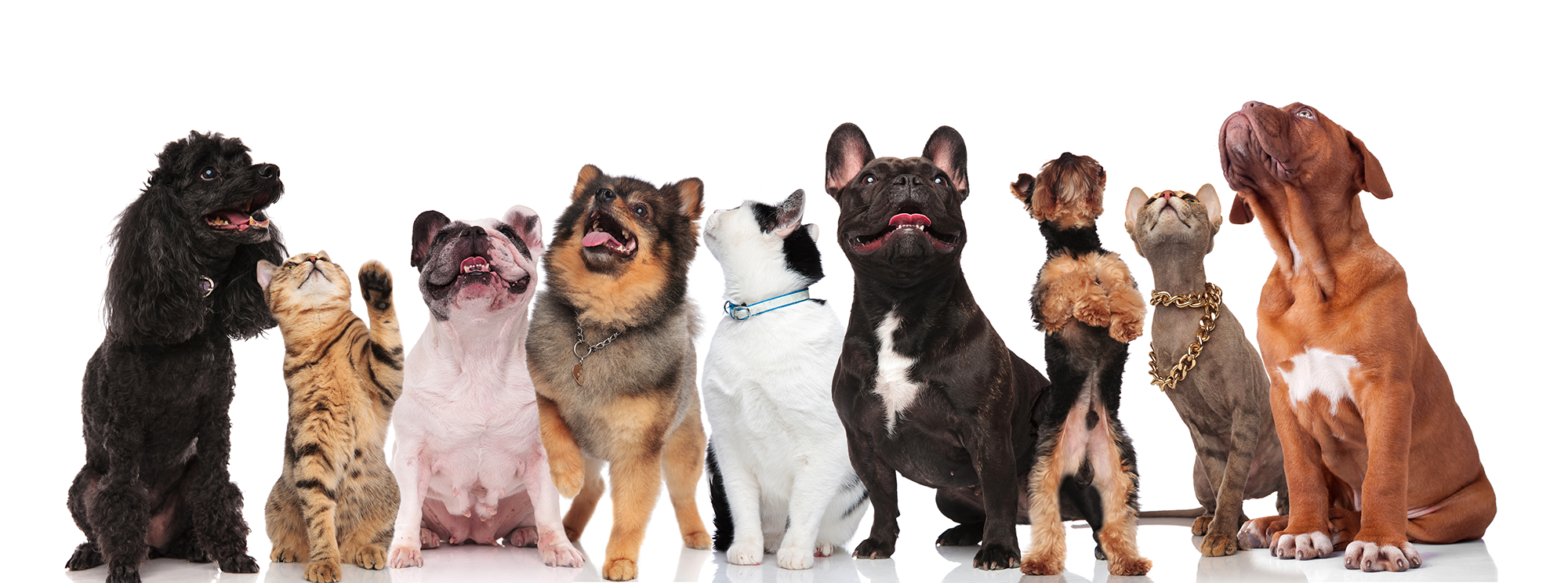
Various brands of pet food are displayed at a pet supplies exhibition in Beijing on March 1, 2024. Photo: VCG
In China, an increasing number of people are enjoying the companionship of pets and treating them as part of the family.
Against the backdrop of rapid development in the pet economy, China's pet food market has experienced explosive growth. However, as the market expands, issues with product quality have emerged.
Recently, a series of news reports have uncovered that some pet food manufacturers, in pursuit of higher profits, resort to using low-quality ingredients for dog, and even falsely label nutritional content, misleading consumers.
In March, a scandal involving "toxic dog food" from Xingtai in North China's Hebei Province, the largest dog food production cluster in China, came to light, causing panic among pet owners across China.
This incident exposed the dark underbelly of the industry and the lack of effective regulation. Some unscrupulous companies have been found falsifying the nutritional content and ingredients of their products, such as overstating the chicken content while using cheaper chicken meal as a substitute.
Worse still, to mask the risks of inferior ingredients, some manufacturers excessively add montmorillonite to pet food, which could severely impact pet health over time.
Given the ineffective enforcement of industry standards, pet owners often find themselves in a battle of wits with unscrupulous manufacturers to ensure the dietary safety of their pets.
With the pet market continuing to grow, there is an urgent need to improve industry standards and strengthen regulation. The question of how to expose the chaos in the industry, attract attention from all sectors of society, and drive the pet food industry toward a healthier and more transparent direction is now a major concern, analysts pointed out.
'Toxic' pet foodIn Xingtai's Nanhe district, recognized as the nation's largest pet food production base with an annual output of over 1.3 million tons, accounting for 60 percent of China's market share, the practice of "using the worst materials for the most expensive feed" was once an unwritten industry rule.
Investigations have revealed that some manufacturers produced pet food with inferior materials for higher profits, even mixing stone and feather meal into their products, as reported by the China National Radio (CNR).
Following the exposure, the Hebei Provincial Department of Agriculture and Rural Affairs responded by investigating the involved companies and taking samples for testing. An official from the Nanhe district agricultural department told the Global Times that the pet food industry is a key development focus for the region, and the scandal has had a significant impact.
A pet food manufacturer in Xingtai confirmed to the Global Times that recent inspections by relevant departments have been strict. He said that dog food purchases are now reliable.
On the sales page of a manufacturer selling pet food on 1688, Alibaba's B2B trading platform, the cheapest dog and cat food from Xingtai sells for less than 10 yuan ($1.43) per kilogram, with different products claiming to cater to puppies, small, medium, or large dogs, and containing various ingredients like beef, fruits and vegetables.
Despite many pet food companies claiming to offer high-quality customized dog and cat food, actual product quality remains poor, with nutritional values often misrepresented. An investigation published by the CNR into a company that outsources dog food production found significant discrepancies between claimed and actual protein content.
Additionally, the use of montmorillonite to absorb toxins has been excessive in "toxic" dog food, reaching about 5 percent when only 0.2 percent is necessary. Overuse of such substances and flavor enhancers to mask the taste of poor-quality feed can have detrimental effects on pet health, according to media reports.
Pet owners vs manufacturers

Workers pack pet food at a factory in Nanhe district in Xingtai, North China's Hebei Province, on July 3, 2019. Photo: VCG
Xin Rui heard of "toxic dog food" for the first time when she adopted a dog from a stray dog shelter in Beijing.
She bought some dog food and dog snacks on the e-commerce platform Tmall the day the dog shelter owner sent the dog to her home.
"Toxic dog food," the stray dog shelter owner said disdainfully with a sideways glance at the bags of dog food casually lying in the living room.
"Honestly, I totally had no idea what she meant when she said the word 'toxic dog food.' I mean, I trust in Tmall supermarket and have bought many things, including food and snacks for myself on the platform. I carefully selected those products to welcome the dog. I did not understand why she said so. I felt so confused," Xin told the Global Times.
Xin bought another bag of dog food from the shelter owner as she recommended in consideration to help the dog get used to its new home sooner. It did not take a long time for Xin to tell the differences between these products. It took a few days for the dog to get used to the food recommended by the stray dog base owner. But the dog entirely refused to eat the food bought on Tmall, even when Xin mixed it with canned meat.
"Dogs are smart. They are helping owners to select safe food," Xin said.
She tried four brands of dog food in the nearly two years after adopting the dog. "I do not trust the base owner as she did not tell me where she got the food. Her price is much lower than that in official stores, making me suspicious about the quality and authenticity of the food," Xin said.
Now Xin buys food from a pet shop near her home. "The employees at the shop can provide official pet nutritionist certificates and they treat pets very nicely, so I choose to trust them. I hope they do not disappoint me," she said.
Actually, Xingtai's case is not unique, and Xin's worry is not unprovoked either.
Many pet owners have taken to social media platforms complaining that their dogs died or got seriously sick, for example by getting pancreatitis, after eating cheap food bought from online channels. Some of the cheap foods were revealed to have had dust and saw powder mixed in.
Even well-known pet food brands are not always trustworthy.
In April 2022, a pet owner in Hangzhou, East China's Zhejiang Province, reported that his cats were poisoned after consuming Singen cat food, with one of them dying. After seeking information online, he discovered that many other families had encountered similar issues. Statistics gathered from 90 individuals revealed similar issues happened with 239 cats, resulting death of 95 cats, reported the Jiemian News.
Singen, founded in the island of Taiwan, claims to have a 50-year history of production. The company's business scope includes the production of veterinary drugs, feed, and feed additives.
Besides the issue of manufacturers falsifying their own products, there have been instances of factories producing counterfeit pet food of major brands.
On March 21, Shanghai-based Observer News reported that the local police department, after thorough investigations, dismantled three dark factories in Central China's Hunan Province and South China's Guangdong Province involved in manufacturing and selling counterfeit cat food of a certain brand.
According to a report on pet market consumption released by e-commerce platform JD.com in late 2023, the number of pet-owning households in China exceeded 100 million in 2023, increasing from 98 million in 2022 to 105.65 million. Among them, the number of pet dogs in 2023 was 51.75 million, a 1.1 percent increase from 2022.
"For China, there is a great potential for the improvement and development of the pet industry. With the improvement of residents' income levels and quality of life, the concept of pet ownership is gradually shifting from guarding the home to emotional companionship. It is expected that in the next 10 years, China will become the world's largest pet market," said Qin Yuchang, president of the pet food branch of the China Feed Industry Association.
Regulating the industry
According to Qin, China's pet industry already reached over 490 billion yuan in 2020, becoming the third-largest service market after Europe and the US. The market size is estimated to reach 800 billion yuan by 2025.
In addition, there has been a significant increase in demand for imported pet feed, with over 600 pet feed import registration certificates issued by the Ministry of Agriculture and Rural Affairs in 2021, a 7.3-fold increase from 2016.
However, compared with the rapidly growing industry, there is still a significant gap in the standards of pet feed in China, which seriously slows the industry's development needs, especially in the standards for pet food additives, with only over 100 of the more than 400 additives having been standardized.
"Some companies' pet food cannot meet the nutritional requirements for young animals, as reflected in the high failure rates of water-soluble chlorides, total calcium, and total phosphorus content. The quality control of animal-derived raw materials, such as meat meal, by companies is insufficient," said Fan Xia, executive deputy director of the National Feed Quality Inspection and Testing Center in Beijing.
In 2018, the Ministry of Agriculture and Rural Affairs of China issued the "Regulations on the Management of Pet Feed," establishing a standardized management system and placing the pet feed industry onto a path of standardized development.
The vast majority of pet feed products have already achieved production certification, but from the market response, there are still some cases of substandard production and production without certification in the production process. It is necessary to increase the publicity and implementation of regulations, and companies must carry out production and operation in accordance with the law and regulations, experts said.
Moreover, many pet feed operators, especially e-commerce and cross-border e-commerce platforms on the internet, have not strictly controlled the quality and safety of their products, leading to the influx of products of varying quality into the market. This requires the strengthening of the supervision of the pet feed industry, continuously improving inspection and testing technology, optimizing the regulatory system. Companies must strictly adhere to the bottom line of quality and safety, experts pointed out.
At the same time, enterprises and operators who violate relevant laws and regulations must be resolutely ordered to rectify, and those who cause serious injury will be held accountable, in order to effectively create a healthy dog food market, Qin stressed.

Photo: VCG






